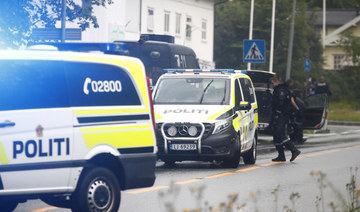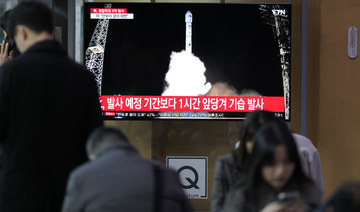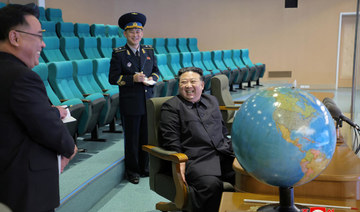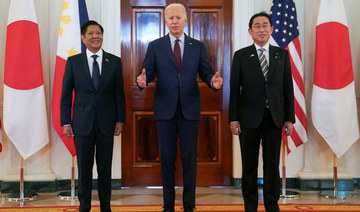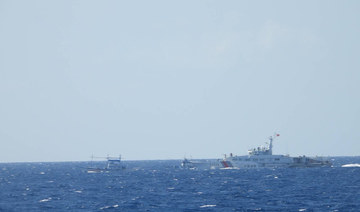PHILADELPHIA: A gunman who opened fire on police Wednesday as they were serving a drug warrant in Philadelphia, wounding six officers and triggering a standoff that extended into the night, is in police custody, authorities said.
Philadelphia police Sgt. Eric Gripp said early Thursday morning that the man was taken into custody after an hourslong standoff with police.
The shooting began around 4:30 p.m. as officers went to a home in a north Philadelphia neighborhood of brick and stone rowhomes to serve a narcotics warrant in an operation “that went awry almost immediately,” Philadelphia Police Commissioner Richard Ross said.
Many officers “had to escape through windows and doors to get (away) from a barrage of bullets,” Ross said.
The six officers who were struck by gunfire have been released from hospitals, Philadelphia police Sgt. Eric Gripp said.
Two other officers were trapped inside the house for about five hours after the shooting broke out but were freed by a SWAT team well after darkness fell on the residential neighborhood. Three people that officers had taken into custody in the house before the shooting started were also safely evacuated.
“It’s nothing short of a miracle that we don’t have multiple officers killed today,” Ross said.
Temple University locked down part of its campus, and several children and staff were trapped for some time in a nearby day care.
Police tried to push crowds of onlookers and residents back from the scene. In police radio broadcasts, officers could be heard calling for backup as reports of officers getting shot poured in.
“I was just coming off the train and I was walking upstairs and there were people running back downstairs who said that there was someone up there shooting cops,” said Abdul Rahman Muhammad, 21, an off-duty medic. “There was just a lot of screaming and chaos.”
Police implored the gunman to surrender, at one point patching in his lawyer on the phone with him to try to persuade him to give up, Ross said.
“We’re doing everything within our power to get him to come out,” Ross said during the standoff. “He has the highest assurance he’s not going to be harmed when he comes out.”
Dozens of officers on foot lined the streets. Others were in cars and some on horses.
The Bureau of Alcohol, Tobacco, Firearms and Explosives said its agents responded to the scene to assist Philadelphia police.
President Donald Trump and Attorney General William Barr were briefed on the shooting, officials said.
Philadelphia Mayor Jim Kenney said he was thankful that officers’ injuries weren’t life-threatening.
“I’m a little angry about someone having all that weaponry and all that firepower, but we’ll get to that another day,” Kenney said.
Philadelphia gunman in custody after hourslong standoff
Philadelphia gunman in custody after hourslong standoff
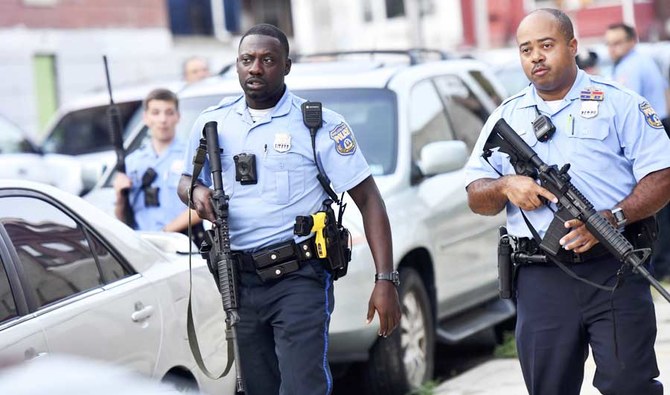
- Local media reported the shooter appeared to have a high-powered weapon and a significant amount of ammunition
Zuma’s party guns for ANC stronghold in South Africa vote

- The emergence of uMkhonto we Sizwe, has increased tension in Kwazulu-Natal, a key election battleground already infamous for political violence
On Monday, rival tents pitched by the two parties outside a local school serving as a polling station blasted party songs welcoming early voters they hoped to sway.
Most South Africans will vote on Wednesday but some, including the elderly and the infirm, were allowed to cast their ballots on Monday in what is expected to be the tightest election in decades.
The emergence of Zuma’s uMkhonto we Sizwe (MK), has increased tension in Kwazulu-Natal, a key election battleground already infamous for political violence.
KwaXimba, a rural area dotted by thatched “rondavel” huts outside the eastern city of Durban, has been ruled by the African National Congress (ANC) since the dawn of democracy in 1994.
But many here revere Zuma, an ethnic Zulu, who was born in the province.
“We’ve needed change for a long time in our lives,” said Thokozani Mthembu, the MK’s local coordinator in KwaXimba.
Some opinion polls suggest that MK could win the most votes in Kwazulu-Natal. This would almost certainly condemn the ANC to its worst electoral result in three decades.
It could lose its parliamentary majority for the first time and be forced to form a coalition government.
Voting proceeded smoothly in KwaXimba during the day, but in a tense atmosphere.
Mthembu claims that after Zuma, 82, held a rally with hundreds of supporters in KwaXimba in January, the party received threats of violence from ANC supporters. Some voters were also wrongly told that the MK would take away social grants and free housing, he said.
The ANC denies all wrongdoing.
“From the day we started our campaign, we’ve had one goal, which is to win the election without threatening other parties,” Sihle Gwala, a local ANC leader, told AFP.
Earlier this month, police warned against “spreading statements that have a potential of inciting violence or create a state of panic in the communities” after a voice note circulated claiming that 11 people were killed in a politically-related shooting.
Many in KwaXimba have turned to the MK, lamenting continuous water and electricity shortages, which some blame on the ANC’s poor management.
Down the road from the school, chickens clucked in 66-year-old Nicolas Ndlovu’s yard, as he walked outside, waiting for election officials to reach his home and allow him to cast his early ballot.
Having fought for the ANC during the anti-apartheid struggle and supported the party all his life, he said he now hoped to see it end up in opposition, so that “maybe they can work harder and earn the power back.”
His village’s streets, where cows roam under the sun, are plastered by campaign posters of the rival parties.
ANC volunteer Jabulile Nduna said the rift between Zuma and her party has caused divisions within her own family.
“I sat (down) my siblings and told them, ‘at the end of the day we have one mother and one father’... whether the MK wins or the ANC wins, we have to remain a family,” said the 43-year-old mother of three, as she walked on a gravel road near a voting station.
During a campaign visit to KwaXimba last month, President Cyril Ramaphosa warned voters about new parties trying to “nibble the edges” of ANC support, saying they would fail to win power.
But some like Nkazimula Makhanya are not heeding the call.
At 26 he has no job and few prospects of getting one, with youth unemployment at 45 percent.
“The old man, as old as he is, he still values our input, and he still allows us to be winners,” he said, referring to Zuma.
Parts of Bangladesh and India affected as storm floods villages, cuts power to millions

- About 3.7 million people along Bangladesh’s coast were affected, disaster ministry says
- Bangladesh, a delta nation of nearly 170 million people, has a history of violent storms
DHAKA, Bangladesh: The weakening tropical storm Remal flooded dozens of coastal villages and left nearly 30 million people without power Monday in southern Bangladesh and eastern India. At least 10 people died in Bangladesh.
About 3.7 million people along the coast were affected, said Bangladesh’s junior minister for disaster management and relief, Mohibbur Rahman. More than 35,000 homes were destroyed and nearly 115,000 were damaged. Nearly 800,000 people were evacuated from vulnerable areas on Sunday.
Bangladesh, a delta nation of nearly 170 million people, has a history of violent storms. Disaster preparedness programs have upgraded the capacity to tackle natural disasters, resulting in fewer casualties. Changing climate patterns have increased storms’ intensity, making preparations more urgent.
Remal weakened after making landfall in Bangladesh’s Patuakhali district early Monday, with sustained winds of 111 kilometers (69 miles) per hour. India’s Meteorological Department said it was likely to weaken throughout the day, but warned of heavy showers over Assam and other northeastern states for the next two days.
India’s Kolkata airport reopened after being shut Sunday. Bangladesh shut the airport in the country’s second largest city, Chattogram, and canceled all domestic flights to and from the coastal district of Cox’s Bazar. Loading and unloading at Chittagong seaport was halted.
Strong rain and winds battered the Bangladesh capital, Dhaka. Many roads were submerged. Authorities ordered all government officials to stay at their stations until the situation improved.
Aid agencies said they deployed thousands of volunteers in Rohingya refugee camps and other affected areas to provide emergency support. Bangladesh has sprawling camps housing more than 1 million Rohingya refugees from Myanmar in Cox’s Bazar.
In India’s West Bengal state, thatched roofs on houses were blown away and electric poles and trees were uprooted in some coastal districts. Heavy downpours inundated streets and homes in low-lying areas of Kolkata. All schools in the region were closed until further notice.
‘Unlikely’ to be more survivors from Papua New Guinea landslide

- Some 2,000 people are feared buried by a massive landslide that entombed a remote highland community
- Full-scale rescue and relief efforts have been severely hampered by the remote location
PORT MORESBY: It is “very unlikely” more survivors of Papua New Guinea’s deadly landslide will be found, a UN agency warned Tuesday, as thousands at risk from further slips were ordered to evacuate.
Some 2,000 people are feared buried by a massive landslide that entombed a remote highland community in the early hours of May 24.
Since then, locals have been picking through a hellscape of meters-deep churned-up earth, uprooted trees and car-sized boulders in the search for loved ones — often using little more than their hands, shovels and digging sticks.
But hopes are dimming that anyone is alive underneath the mountain of rubble.
“It is not a rescue mission, it is a recovery mission,” UNICEF Papua New Guinea’s Niels Kraaier said. “It is very unlikely they will have survived.”
Full-scale rescue and relief efforts have been severely hampered by the remote location, the only road link being severed, heavy rainfall and nearby tribal violence.
The Papua New Guinea Defense Forces have struggled to access the site with heavy earth-moving equipment.
Early on Tuesday, Enga provincial administrator Sandis Tsaka warned the disaster could worsen further, as clumps of limestone, dirt and rock continue to shear off the side of Mount Mungalo.
Tsaka said authorities were now trying to coordinate the evacuation of almost 7,900 more people.
“The tragedy is still active,” he said. “Every hour you can hear rock breaking — it is like a bomb or gunshot and the rocks keep falling down.”
Aid officials said many residents were refusing to leave at-risk areas because they were holding out hope of finding loved ones.
Satellite images show the enormous scale of the disaster.
A vast smear of yellow and grey debris can be seen cutting through once verdant bushland and severing the region’s only road.
“This was an area heavily populated with homes, businesses, churches and schools, it has been completely wiped out. It is the surface of the moon — it is just rocks,” said Tsaka.
“People are digging with their hands and fingers,” he said, expressing anguish at the unde-resourced government’s inability to meet the enormity of the disaster.
“I am not equipped to deal with this tragedy,” Tsaka admitted.
Overwhelmed Papua New Guinea authorities held an online emergency meeting with United Nations agencies and international allies Tuesday, hoping to kickstart the relief effort.
Papua New Guinea’s national disaster center has told the United Nations that the initial “landslide buried more than 2,000 people alive.”
According to a letter obtained by AFP, the slide also “caused major destruction to buildings, food gardens and caused major impact on the economic lifeline of the country.”
The scale of the catastrophe required “immediate and collaborative actions from all players,” it added, including the army, and national and provincial responders.
Australia has announced millions of dollars worth of aid, including emergency relief supplies such as shelters, hygiene kits and support for women and children.
China’s President Xi Jinping and his US counterpart Joe Biden — more accustomed to scrapping for influence in the strategically located country — both offered assistance.
More than 1,000 people have already been displaced by the catastrophe, aid agencies have estimated.
UN Development Programme official Nicholas Booth said up to 30,000 people could have been cut off by the disaster across several villages.
These communities had enough supplies for the coming weeks, but opening up that road remained essential, he said.
“This landslide has blocked the road westward, so not only are there challenges in accessing the village itself, but it does mean the communities beyond that are also cut off.”
Locals said the landslip may have been triggered by recent heavy rains.
Papua New Guinea has one of the wettest climates in the world, and research has found shifting rainfall patterns linked to climate change could exacerbate the risk of landslides.
The estimated death toll has climbed significantly since the disaster struck, as officials reassess the size of the population.
Many people fleeing tribal violence have moved into the area in the past few years.
The area is located about 600 kilometers from Port Moresby.
Rocket carrying North Korea’s second spy satellite explodes shortly after launch

- Setback for leader Kim Jong Un’s hopes to operate multiple satellites to better monitor the US and South Korea
- Rocket blew up during a first-stage flight soon after liftoff due to a suspected engine problem
SEOUL: A rocket launched by North Korea to deploy the country’s second spy satellite exploded shortly after liftoff Monday, state media reported, in a setback for leader Kim Jong Un’s hopes to operate multiple satellites to better monitor the US and South Korea.
Monday’s failed launch came hours after leaders of South Korea, China and Japan met in Seoul in their first trilateral meeting in more than four years. It’s highly unusual for North Korea to take provocative action when China, its major ally and economic pipeline, is engaging in high-level diplomacy in the region.
The launch drew rebukes from the North’s neighbors because the UN bans North Korea from conducting any such launches, viewing them as covers for testing long-range missile technology.
The North’s official Korean Central News Agency said it launched a spy satellite aboard a new rocket at its main northwestern space center. But KCNA said the rocket blew up during a first-stage flight soon after liftoff due to a suspected engine problem.
KCNA cited the unidentified vice director of the National Aerospace Technology Administration as saying that a preliminary examination showed that the explosion was related to the reliability of operation of the newly developed liquid oxygen-petroleum engine. He said other possible causes will be investigated, according to KCNA.
Japan’s government briefly issued a missile warning for the southern prefecture of Okinawa, urging residents to take shelter inside buildings and other safer places. The warning was lifted later because the region was no longer in danger, Chief Cabinet Secretary Yoshimasa Hayashi said.
Japanese Defense Minister Minoru Kihara called the North’s launch “a serious challenge to the entire world.” The US Indo-Pacific Command criticized the launch as a “brazen violation” of UN Security Council resolutions and said it involved technologies that are directly related to North Korea’s intercontinental ballistic missile program. South Korea’s Unification Ministry called a satellite launch by the North “a provocation that seriously threatens our and regional security.”
North Korea has steadfastly maintained it has the right to launch satellites and test missiles in the face of US-led military threats. North Korea says the operation of spy satellites will allow it to better monitor the US and South Korea and improve the precision-striking capabilities of its missiles.
During the trilateral meeting with Japanese Prime Minister Fumio Kishida and Chinese Premier Li Qiang earlier Monday, South Korean President Yoon Suk Yeol called for stern international action if North Korea went ahead with its launch plan.
Kishida, for his part, urged the North to withdraw its launch plan, but Li didn’t mention the launch plan as he offered general comments about promoting peace and stability on the Korean Peninsula through a political resolution.
Earlier Monday, North Korea had notified Japan’s coast guard about its planned launch with a warning to exercise caution in the waters between the Korean Peninsula and China and east of the main Philippine island of Luzon during a launch window from Monday through June 3.
Some observers say that North Korea’s satellite launch on the first day of its eight-day window might have been aimed at casting a chill over the Seoul-Beijing-Tokyo meeting and registering its displeasure with China. Kim Jong Un has been embracing the idea of a “new Cold War” and seeking to boost ties with Beijing and Moscow to forge a united front against Washington, so China’s diplomacy with Seoul and Tokyo might have been a disturbing development for Pyongyang.
Kim’s primary focus in recent months has been on Russia, as Pyongyang and Moscow — both locked in confrontations with Washington — expand their military cooperation. China, which is much more sensitive about its international reputation, has joined Russia in blocking US-led efforts at the UN Security Council to tighten sanctions on the North but has been less bold and open about supporting Kim’s “new Cold War” drive.
North Korea’s Foreign Ministry on Monday strongly criticized a joint statement issued by Li, Yoon and Kishida, calling it “wanton interference in its internal affairs.” The ministry took issue with parts of the joint statement that said the three leaders re-emphasized their existing positions on the issue of denuclearization of the Korean Peninsula.
While North Korea focused much of its criticism on South Korea for allegedly being chiefly responsible for the statement, it’s still extremely rare for North Korea to slam a statement signed by China.
The failed satellite launch is a blow to Kim’s plan to launch three more military spy satellites in 2024 in addition to his country’s first military reconnaissance satellite that was placed in orbit last November.
The November launch followed two failed liftoffs.
In the first attempt, the North Korean rocket carrying the satellite crashed into the ocean soon after liftoff. After the second attempt, North Korea said there was an error in the emergency blasting system during the third-stage flight.
China, US agree to manage maritime risks through continued dialogue

- Beijing expressed serious concern over the US’ infringement of and provocations in nearby waters
- China has also urged the United States to not take sides in South China Sea
HONG KONG: China and the United States held consultations on maritime affairs in which both countries agreed to maintain dialogue and manage risks, the Chinese Foreign Ministry said on Tuesday.
China said both sides exchanged views last Friday on the maritime situation, agreed to maintain communication, and avoid misunderstandings and miscalculations.
The foreign ministry said China expressed serious concern over the United States’ infringement of and provocations in nearby waters, and urged the Washington to refrain from intervening in disputes between China and its neighbors, or “use the sea to control China.”
The United States should immediately stop supporting and condoning “Taiwan independence” forces, the ministry added.
The Unite States maintains direct interactions with Taiwan, including arms sales, which Beijing opposes. China claims democratically governed Taiwan as its own territory, but Taiwan’s government rejects Beijing’s sovereignty claims.
China has also urged the United States to not take sides in South China Sea, after Washington in March extended a security deal with the Philippines to include attacks on the Southeast Asian nation’s coast guard.






